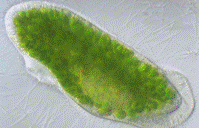Papers in the Biological Sciences
Document Type
Article
Date of this Version
10-27-2009
Abstract
Despite the importance of plant–herbivore interactions to the ecology and evolution of terrestrial ecosystems, the evolutionary factors contributing to variation in plant defenses against herbivores remain unresolved. We used a comparative phylogenetic approach to examine a previously untested hypothesis (Recombination-Mating System Hypothesis) that posits that reduced sexual reproduction limits adaptive evolution of plant defenses against arthropod herbivores. To test this hypothesis we focused on the evening primrose family (Onagraceae), which includes both sexual and functionally asexual species. Ancestral state reconstructions on a 5-gene phylogeny of the family revealed between 18 and 21 independent transitions between sexual and asexual reproduction. Based on these analyses, we examined susceptibility to herbivores on 32 plant species representing 15 independent transitions. Generalist caterpillars consumed 32% more leaf tissue, gained 13% greater mass, and experienced 21% higher survival on functionally asexual than on sexual plant species. Survival of a generalist feeding mite was 19% higher on asexual species. In a field experiment, generalist herbivores consumed 64% more leaf tissue on asexual species. By contrast, a specialist beetle fed more on sexual than asexual species, suggesting that a tradeoff exists between the evolution of defense to generalist and specialist herbivores. Measures of putative plant defense traits indicate that both secondary compounds and physical leaf characteristics may mediate this tradeoff. These results support the Recombination-Mating System Hypothesis and suggest that variation in sexual reproduction among plant species may play an important, yet overlooked, role in shaping the macroevolution of plant defenses against arthropod herbivores.
Supplementary material


Comments
Published in the Proceedings of the National Academy of Sciences of the United States of America (October 27, 2009) 106(43): 18,079-18,084. Copyright 2009, the authors. Used by permission. Edited by Douglas J. Futuyma. Supplementary material is available at http://www.pnas.org/cgi/content/full/0904695106/DCSupplemental